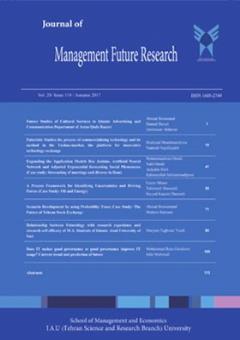Designing and validating the model of digital entrepreneurship eco-makers in educational organizations
Subject Areas : Futurology
Neda Khodadadeh
1
,
maryam eslampanah
2
,
faranak mosavi
3
![]() ,
Elham Kavieani
4
,
Elham Kavieani
4
1 - PhD student in educational management, faculty of literature and humanities, department of educational management, Kermanshah branch, Islamic Azad University, Kermanshah, Iran.
2 - Assistant professor and faculty member, Department of Educational Management, Kermanshah Branch, Islamic Azad University, Kermanshah, Iran.
3 - Associate Professor and Faculty Member, Educational Management Department, Kermanshah Branch, Islamic Azad University, Kermanshah, Iran.
4 - Assistant Professor and Faculty Member, Department of Educational Management, Kermanshah Branch, Islamic Azad University, Kermanshah, Iran.
Keywords: Entrepreneurship, Digital Entrepreneurship, Ecologists, Educational Organization,
Abstract :
The ecosystem of digital entrepreneurship in educational organizations has recently emerged as a common concept in entrepreneurship policy and educational organizations. The present study was conducted to design and validate the model of digital entrepreneurship ecologists in educational organizations. The research method is mixed exploration (qualitative-quantitative) which in the qualitative part is the method of data theory and in the quantitative part is a survey. The participants of the quality department are 15 faculty members of entrepreneurship universities, specialists and experts familiar with digital entrepreneurship in educational organizations who have been selected using purposive sampling method from a consecutive category. Entrepreneurship specialists and university professors related to the field of entrepreneurship were selected by 135 people by stratified random sampling method. The method of analysis of interview data is selected in the qualitative part, open coding, axial and selective and in the quantitative part of structural equations. Findings of the research in the qualitative section include 483 open codes, 42 secondary codes and 15 categories that were obtained in 6 main axes (axial, causal conditions, contextual conditions, intervening factors, strategies and consequences). The results of the quantitative section showed that the proposed model has a good fit. According to the results, this model can be used in educational organizations and by recognizing it, the main effects on the role, responsibility and activities of educational organizations in the present era can be done and managers of educational organizations pay attention to the importance of this research. Adequate and effective.


